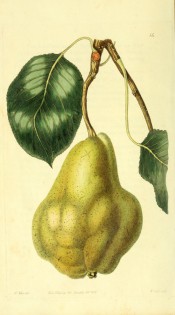Pyrus communis ‘Summer Bonchrétien’
‘Fruit large, irregularly pyramidal, about four inches long, and three inches in diameter, exceedingly knobby and irregular in its outline, particularly about the eye. Eye small, prominent, in a narrow, shallow, obtuse-angled basin. Stalk two inches and a half long, irregular and crooked, very obliquely inserted, in a knobby, irregular cavity. Skin, when fully ripe, of a pale lemon colour, very slightly tinged with red on the sunny side, and covered all over with small green dots. Flesh yellowish, breaking, firm, juicy, very sweet and excellent. Cone very small, placed near the eye. Ripe the middle of September.’ [George Lindley – Orchard Guide p.349/1831]. It is unclear why a pear that ripens in autumn should be called ‘Summer Bonchrétien’.
Horticultural & Botanical History
‘A valuable, well-known Autumn Pear, the origin of which is lost in the darkness of antiquity. It has long been cultivated all over Europe, for the sake of the size and the delicious flavour of its fruit; but in this country its place is too often supplied by inferior varieties, whose merit is more frequently novelty than excellence.
By some Pomologists it is supposed to be the Regalia of Valerius Cordus; the Piri di Gacemella of Agostino Gallo; and the Domestica, Pentagomim perelegans, and Pugillarium Bollense, of John Bauhin. If these conjectures be correct, its origin must be dated as far back, at least, as the beginning of the sixteenth century, and probably much higher. It is quite certain that it has found a place in every work of consequence for the last 150 years.
Upon the continent it is known by a great number of different names. In Italy it is called Gracioli and Gratiola di Roma; in Holland, Zomer Safraan, Apotheker Peer, Kanneelpeer, Sucker Kandijpeer, Kanjerweel, Kruidkanjerweel, Marsepeinpeer, and Schager Magd; in some parts of Germany, Malvasierbirne and Strasburgerbirne; in Wurtemberg and Anspach it has the name of Zuckerbirne; in Thuringia, of Zuckeradenbirne; and, finally, in Vienna, it is known by the name of Plutzerbirne, from its resemblance in form to a wine-flask.
The Germans distinguish two varieties of this, the large and the small: whether they both exist in this country is not certain; but the old figure in Batty Langley's Pomona, t.65, is so unlike the common form of the Summer Bonchretien, that it is possible they do.’ [PM t.14/1828].
Also figured in Pomona Britannica [PB pl.LXXX/1812] and Saint-Hilaire [pl.30/1828].
History at Camden Park
Listed in the 1850 and 1857 catalogues [Pear no.29/1850]. In his Diary Macarthur expresses doubt about this pear, suggesting that it may be ‘Same as No. 4 ? [Cape Pear]’ but with a query. [Diary B, MP A2951/1862]. This raises the possibility that ‘Cape Pear’, the identity of which is unknown, is ‘Summer Bonchrétien’.
Notes
Published May 19, 2010 - 10:30 AM | Last updated Jul 22, 2011 - 02:08 PM
| Family | Rosaceae |
|---|---|
| Category | |
| Region of origin | Garden origin, unknown |
| Synonyms |
|
| Common Name | Dessert Pear, autumn |
| Name in the Camden Park Record |
Summer ditto
|
| Confidence level | medium |
